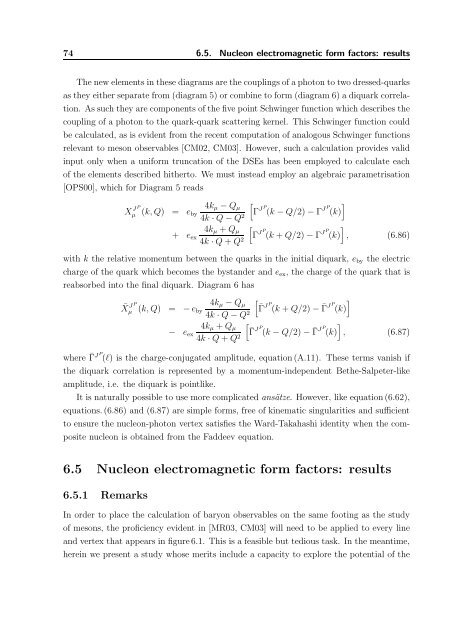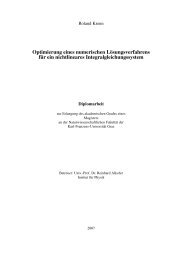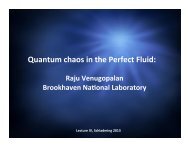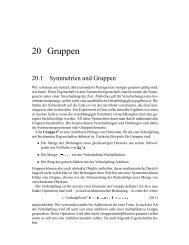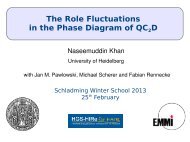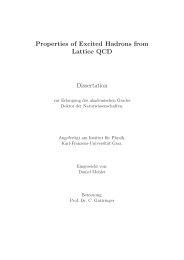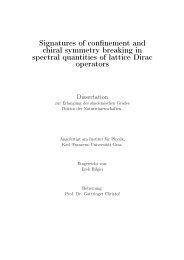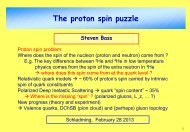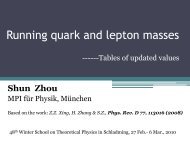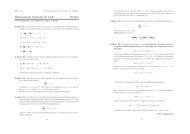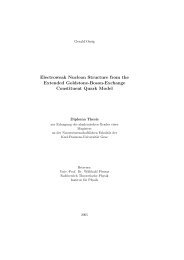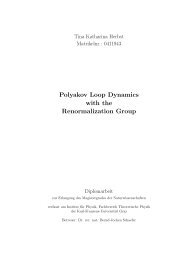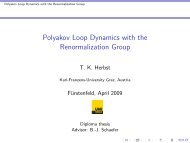The QCD Quark Propagator in Coulomb Gauge and - Institut für Physik
The QCD Quark Propagator in Coulomb Gauge and - Institut für Physik
The QCD Quark Propagator in Coulomb Gauge and - Institut für Physik
You also want an ePaper? Increase the reach of your titles
YUMPU automatically turns print PDFs into web optimized ePapers that Google loves.
74 6.5. Nucleon electromagnetic form factors: results<br />
<strong>The</strong> new elements <strong>in</strong> these diagrams are the coupl<strong>in</strong>gs of a photon to two dressed-quarks<br />
as they either separate from (diagram 5) or comb<strong>in</strong>e to form (diagram 6) a diquark correlation.<br />
As such they are components of the five po<strong>in</strong>t Schw<strong>in</strong>ger function which describes the<br />
coupl<strong>in</strong>g of a photon to the quark-quark scatter<strong>in</strong>g kernel. This Schw<strong>in</strong>ger function could<br />
be calculated, as is evident from the recent computation of analogous Schw<strong>in</strong>ger functions<br />
relevant to meson observables [CM02, CM03]. However, such a calculation provides valid<br />
<strong>in</strong>put only when a uniform truncation of the DSEs has been employed to calculate each<br />
of the elements described hitherto. We must <strong>in</strong>stead employ an algebraic parametrisation<br />
[OPS00], which for Diagram 5 reads<br />
Xµ JP<br />
(k, Q) = e 4k µ − Q<br />
[<br />
]<br />
µ<br />
by Γ JP (k − Q/2) − Γ JP (k)<br />
4k · Q − Q 2<br />
4k µ + Q<br />
[<br />
]<br />
µ<br />
+ e ex Γ JP (k + Q/2) − Γ JP (k) , (6.86)<br />
4k · Q + Q 2<br />
with k the relative momentum between the quarks <strong>in</strong> the <strong>in</strong>itial diquark, e by the electric<br />
charge of the quark which becomes the byst<strong>and</strong>er <strong>and</strong> e ex , the charge of the quark that is<br />
reabsorbed <strong>in</strong>to the f<strong>in</strong>al diquark. Diagram 6 has<br />
4k<br />
¯X µ JP<br />
µ − Q µ<br />
(k, Q) = −e by<br />
[¯ΓJ P (k + Q/2) −<br />
4k · Q − Q ¯Γ<br />
]<br />
JP<br />
(k)<br />
2<br />
4k µ + Q µ<br />
− e ex<br />
[¯ΓJ P (k − Q/2) −<br />
4k · Q + Q ¯Γ<br />
]<br />
JP<br />
(k) , (6.87)<br />
2<br />
where ¯Γ JP (l) is the charge-conjugated amplitude, equation(A.11). <strong>The</strong>se terms vanish if<br />
the diquark correlation is represented by a momentum-<strong>in</strong>dependent Bethe-Salpeter-like<br />
amplitude, i.e. the diquark is po<strong>in</strong>tlike.<br />
It is naturally possible to use more complicated ansätze. However, like equation(6.62),<br />
equations.(6.86) <strong>and</strong> (6.87) are simple forms, free of k<strong>in</strong>ematic s<strong>in</strong>gularities <strong>and</strong> sufficient<br />
to ensure the nucleon-photon vertex satisfies the Ward-Takahashi identity when the composite<br />
nucleon is obta<strong>in</strong>ed from the Faddeev equation.<br />
6.5 Nucleon electromagnetic form factors: results<br />
6.5.1 Remarks<br />
In order to place the calculation of baryon observables on the same foot<strong>in</strong>g as the study<br />
of mesons, the proficiency evident <strong>in</strong> [MR03, CM03] will need to be applied to every l<strong>in</strong>e<br />
<strong>and</strong> vertex that appears <strong>in</strong> figure6.1. This is a feasible but tedious task. In the meantime,<br />
here<strong>in</strong> we present a study whose merits <strong>in</strong>clude a capacity to explore the potential of the


